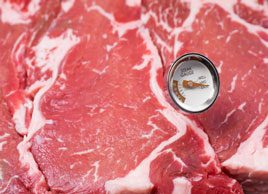4 myths about food poisoning, busted
The causes of food-borne illness aren’t as obvious as you may think. Here’s how you can reduce your risk of food poisoning

Source: Web exclusive, July 2011
It’s often said that Canada has one of the safest food supplies in the world, but food poisoning occurs between 11 and 13 million times a year in this country. How can we protect ourselves further?
Learning about food-related hazards can help you reduce the risk. "I think that people’s attitudes towards food-borne illness are directly relatable to the amount of knowledge they have in the area," says Rick Holley, a professor in the Department of Food Science at the University of Manitoba.
Read on to learn what really causes food poisioning, and what’s just a myth.
Myth: You most likely got food poisoning from the last thing you ate.
Truth: We’ve all been there: In the middle of the night, awake for hours with symptoms such as abdominal cramps, nausea, vomiting, diarrhea, fever and chills, cursing the restaurant we visited that night and pledging never to return.
Food-borne illnesses can occur within a few hours of ingesting a meal, but most cases happen within two to five days’others can take weeks or even months to cause symptoms. The cause of what ails you may never be known, so don’t be so quick to think the local pizzeria has a dirty kitchen.
Even foods prepared in the cleanest kitchens could cause illness, due to contamination at their source of packaging. The machinery used to process and grind meat, for example, can spread pathogens. Canneries can also cause mass contamination through tainted equipment if proper cleaning procedures are not followed.
Myth: Animal products are the most likely source of food-borne illness.
Truth: Animal products such as processed meats and unpasteurized cheese are high on most people’s list of concerns, for good reason. With poultry, low "base level" numbers of pathogens like salmonella bacteria will always be present. Letting it sit on the counter for too long before cooking allows those populations to grow.
But fruits and vegetables are a growing source of contamination, accounting for about a quarter of cases of food poisoning, says Holley. "If you look at the data that we have from 20 years ago, food of animal origin was far more frequently the cause of illness, but now we are seeing produce come close to a balance with animal products," he says.
Some of the most common sources of contamination for produce such as spinach are unsafely treated manure, unsafe practices among farm workers (such as picking vegetables while sick), wildlife and contaminated irrigation water.
Myth: All food bought from the supermarket should be safe.
Truth: Since 1997, food imports have increased by approximately 45 percent, and about 70 percent of the food we eat now comes from another country, says Holley. The U.S. is still our largest source of imported food, but we also receive a lot of food from countries within the European Union, as well as Mexico, Brazil and China.
This can pose a raft of risks to consumers, since products we import may have been treated with chemicals and pesticides that are banned in Canada’the use of which we have no ability to regulate. Holley notes, however, that if the Canadian Food Inspection Agency were to detect the presence of banned substances, that food product would be refused entry into the country.
Shrimp farming in developing countries is not well regulated, and has become extremely intensive. Shrimp are grown in dense populations, which can increase the potential spread of pathogens. "There are a lot of questionable practices associated with aquaculture in developing countries," says Holley. “Issues such as pesticide residues are top of mind in a country like India, for example, which is the second-largest aquaculture producer, after China.”
Unfortunately, these issues tend to stay below our collective radar until we see scary news reports about contaminated foods, such as E.coli on Egyptian fenugreek seeds, or salmonella found in American eggs.
But outside sources are not to blame for all food-borne illness. Eating more local foods can take some of the risk out of your daily diet, but Holley points out that the means we take to ensure food safety within our own borders are far from perfect.
Myth: Food cooked at home is always safe.
Truth: The most frequent sources of food poisoning are food service and catering, such as in hospitals and restaurants. "But the second most common is in the home," says Holley. "If our own house is in order, things will improve tremendously."
Here are some simple food safety guidelines you can practise at home:
‘ Avoid cross-contamination between meat and vegetables by using separate utensils (and sanitize all surfaces and utensils before you use them).
‘ Never rinse meat before eating it, because rinsing can scatter bacteria and viruses throughout the kitchen.
‘ Never leave meat sitting on the counter for long periods of time; that allows low-level populations of bacteria to explode and multiply.
‘ Use a meat thermometer and cook foods to the appropriate temperature to make sure you kill bacteria.
‘ Do not use food from dented or bulging cans’they can harbour botulism.
‘ And, of course, wash your hands frequently with soap.
Don’t miss out! Sign up for our free weekly newsletters and get nutritious recipes, healthy weight-loss tips, easy ways to stay in shape and all the health news you need, delivered straight to your inbox.




